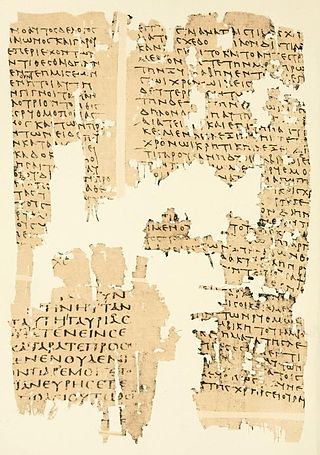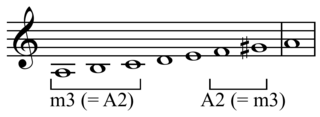
In music, harmony is the concept of combining different sounds together in order to create new, distinct musical ideas. Theories of harmony seek to describe or explain the effects created by distinct pitches or tones coinciding with one another; harmonic objects such as chords, textures and tonalities are identified, defined, and categorized in the development of these theories. Harmony is broadly understood to involve both a "vertical" dimension (frequency-space) and a "horizontal" dimension (time-space), and often overlaps with related musical concepts such as melody, timbre, and form.

Aristoxenus of Tarentum was a Greek Peripatetic philosopher, and a pupil of Aristotle. Most of his writings, which dealt with philosophy, ethics and music, have been lost, but one musical treatise, Elements of Harmony, survives incomplete, as well as some fragments concerning rhythm and meter. The Elements is the chief source of our knowledge of ancient Greek music.

Xanthippe was an ancient Athenian, the wife of Socrates and mother of their three sons: Lamprocles, Sophroniscus, and Menexenus. She was likely much younger than Socrates, perhaps by as much as 40 years.
In the musical system of ancient Greece, genus is a term used to describe certain classes of intonations of the two movable notes within a tetrachord. The tetrachordal system was inherited by the Latin medieval theory of scales and by the modal theory of Byzantine music; it may have been one source of the later theory of the jins of Arabic music. In addition, Aristoxenus calls some patterns of rhythm "genera".
Nomos Alpha is a piece for solo cello composed by Iannis Xenakis in 1965, commissioned by Radio Bremen for cellist Siegfried Palm, and dedicated to mathematicians Aristoxenus of Tarentum, Évariste Galois, and Felix Klein. This piece is an example of a style of music called, by Xenakis, symbolic music – a style of music which makes use of set theory, abstract algebra, and mathematical logic in order to create and analyze musical compositions. Along with symbolic music, Xenakis is known for his development of stochastic music.

Rudolf Westphal was a German classical scholar.
In music and prosody, arsis and thesis are respectively the stronger and weaker parts of a musical measure or poetic foot. However, because of contradictions in the original definitions, writers use these words in different ways. In music, arsis is an unaccented note (upbeat), while the thesis is the downbeat. However, in discussions of Latin and modern poetry the word arsis is generally used to mean the stressed syllable of the foot, that is, the ictus.
Phanto of Phlius, was a Pythagorean philosopher, and one of the last of the school until the Neopythagorean revival in the Roman era. He was a disciple of Philolaus and Eurytus, and, probably in his old age, contemporary with Aristoxenus, the Peripatetic philosopher, c. 320 BC.
The Academy of Music in Baltimore, Maryland was an important music venue in that city after opening in 1875 following the American Civil War. The Academy was located at 516 North Howard Street. The Academy was closed and demolished in 1927 for the construction of the Stanley Theatre, Baltimore's largest and most opulent theatre.
Aristoxenus was a Greek physician of Asia Minor who was quoted by Caelius Aurelianus. He was a pupil of Alexander Philalethes and contemporary of Demosthenes Philalethes, and must therefore have lived around the 1st century BC. He was a follower of the teachings of Herophilos, and studied at the celebrated Herophilean school at the village of Men-Carus, between Laodicea and Carura. He wrote a work Περὶ τῆς Ἡροφίλου Αἱρέσεως, of which the thirteenth book is quoted by Galen, but which is no longer extant.

Xenophilus, of Chalcidice, was a Pythagorean philosopher and musician who lived in the first half of the 4th century BC. Aulus Gellius relates that Xenophilus was the intimate friend and teacher of Aristoxenus and implies that Xenophilus taught him Pythagorean doctrine. He was said to have belonged to the last generation of Pythagoreans, and he is the only Pythagorean known to have lived in Athens in the 4th century BC.
The musical system of ancient Greece evolved over a period of more than 500 years from simple scales of tetrachords, or divisions of the perfect fourth, into several complex systems encompassing tetrachords and octaves, as well as octave scales divided into seven to thirteen intervals.

Agrias amydon, the Amydon agrias or white-spotted agrias, is a butterfly of the family Nymphalidae. It is found in Mexico, Central America, and South America.

Myrto was, according to some accounts, a wife of Socrates.

Traditionally in Western music, a musical tone is a steady periodic sound. A musical tone is characterized by its duration, pitch, intensity, and timbre. The notes used in music can be more complex than musical tones, as they may include aperiodic aspects, such as attack transients, vibrato, and envelope modulation.
Themistoclea was, according to surviving sources, Pythagoras’ teacher while a priestess at Delphi.

Papyrus Oxyrhynchus 9 is a fragment of the "Ruthmica Stoicheia" of Aristoxenus of Tarentum, written in Greek. It was discovered by Grenfell and Hunt in 1897 in Oxyrhynchus, in Middle Egypt. The fragment is dated to the third century. It is housed at Trinity College, Dublin. The text was published by Grenfell and Hunt in 1898.

An incomposite interval is a concept in the Ancient Greek theory of music concerning melodic musical intervals between neighbouring notes in a tetrachord or scale which, for that reason, do not encompass smaller intervals. Aristoxenus defines melodically incomposite intervals in the following context:
Let us assume that given a systēma, whether pyknon or non-pyknon, no interval less than the remainder of the first concord can be placed next above it, and no interval less than a tone next below it. Let us also assume that each of the notes which are melodically successive in each genus will either form with the fourth note in order from it the concord of a fourth, or will form with the fifth note from it in order the concord of a fifth, or both, and that any note of which none of these things is true is unmelodic relative to those with which it forms no concord. Let us further assume that given that there are four intervals in the fifth, of which two are usually equal and two unequal, the unequal ones are placed next to the equal ones in the opposite order above and below. Let us assume that notes standing at the same concordant interval from successive notes are in succession with one another. Let us assume that in each genus an interval is melodically incomposite if the voice, in singing a melody, cannot divide it into intervals.

7-limit or septimal tunings and intervals are musical instrument tunings that have a limit of seven: the largest prime factor contained in the interval ratios between pitches is seven. Thus, for example, 50:49 is a 7-limit interval, but 14:11 is not.
Elementa harmonica is a treatise on the subject of musical scales by Aristoxenus, of which considerable amounts are extant. The work dates to the second half of the 4th century BC. It is the oldest substantially surviving work written on the subject of music theory.












